- Fallout 4 Settlement Build Ideas – A Whole New Sanctuary - May 18, 2023
- Fallout New Vegas Come Fly With Me Guide - April 15, 2023
- Fallout 3 The Power of Atom Guide - April 2, 2023
There has been a civil war of sorts between certain groups of gamers that have raged on for over a decade now. The argument over which developer has produced the best Fallout franchise title to ever grace our screens.
It seems that despite the progressive and refined storytelling present in the Interplay and Black Isle Studios iterations in the 1990s, the fans of this series have settled on one of two answers. As a collective, it seems that they have settled on Fallout 3 or Fallout New Vegas.
Bethesda led the charge in this respect, buying the rights to this very well-respected property and dragging it into what was then the seventh generation of gaming. Players were able to witness a 1st or 3rd-person Fallout adventure that combined the old-school RPG mechanics with the more accepted and commercially appealing FPS gameplay format that was popular in the era.
However, when Bethesda handed the reigns over to Obsidian Entertainment temporarily to produce a spin-off title while they began production on Fallout 4, they could hardly have expected this group of RPG specialists working with their outdated engine and shared assets, on a very tight deadline to produce a game as refined as they did.
The debate rages on, and players often find themselves standing up for their preferred wasteland adventure. Well, in this article, we aim to offer a measured and unbiased argument for both titles and come to a definite conclusion as to which title reigns supreme. So without further delay, here is our Fallout 3 vs New Vegas Guide!
For you impatient gamers that just want the cliff notes so that you can scurry off into a chatroom somewhere loaded up on knowledge, serving as ammunition to win your latest Fallout-based discussion.
We have listed below all of the key differences between the two games, showing both their strengths and weaknesses and giving you a quick overview of what we will discuss at length below. Check it out:
Main Differences Between Fallout 3 vs New Vegas
The main differences between Fallout 3 vs New Vegas are:
- Fallout 3, in terms of tone and narrative, is a much more gritty and linear affair, whereas FNV has a narrative that is much more light-hearted and open-ended.
- In terms of world design, Fallout 3 has a larger map with much more open space and clever design to make them more dense areas seem vast, whereas FNV has a smaller, much more densely packed map with many more points of interest
- Fallout 3 struggles to invent new ideas within the series, instead, regurgitating old ideas and butchering the execution on several occasions, whereas FNV understands and respects the early Fallout lore and adds new content rather than re-inventing old assets.
- Fallout 3 offers gameplay that marries FPS and RPG ideals and is the first game in the series to implement the VATS system, whereas FNV takes this framework and offers quality of life improvements and game balancing to offer a refined experience. The prime examples are DT as opposed to DR, Iron Sights, VATS balancing, and more
- Fallout 3 introduced a karma system that offered players the ability to play as a good, bad or neutral character, whereas FNV used a faction system that made the player’s role in the universe more nuanced than simply good or bad.
Writing and Narrative
Fallout 3
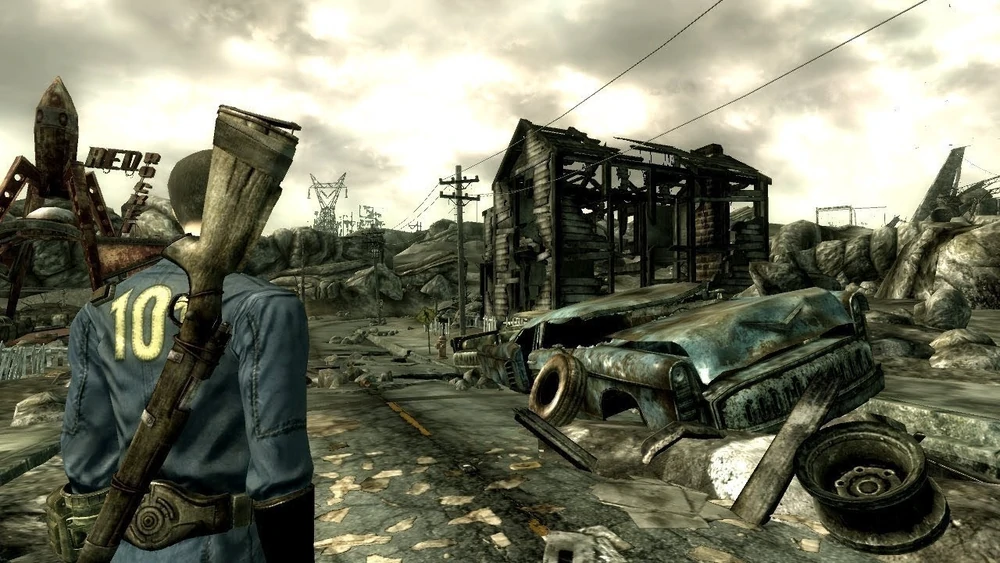
We begin proceedings with the overall narrative and, specifically, Fallout 3’s narrative. If there is one thing that Bethesda have struggled to do across their flagship franchises (Elder Scrolls and Fallout), it has been writing a cohesive, interesting, and well-paced main story, and in Fallout 3, this is very apparent. The concept is bang on and on-brand.
The player grows up in Vault 101, Liam Neeson, your lovely father, runs away, and you must wander off into the vast open wastes to find him. Then the story expands from there. However, it never really gets going.
Apart from some standout moments like Tranquility Lane or fighting the Behemoth at Galaxy News Radio, the main story feels like a drag. It always feels like the game is leaning heavily on the fantastic writing and lore constructed in the 1990s, but it’s then presented in a slap-dash way that makes a mockery of the source material.
There is no depth to the writing, there are no real choices to speak of, and those that you do are effectively do the good thing or the bad thing. What I am saying here is that there is zero nuance about this game.
If you strip away the Fallout IP, this could easily be a mediocre FPS game with RPG elements. Think of the campaigns seen in games of the era like Haze or Killzone. Without the IP to lean on here, I honestly believe that would be the level of narrative that Bethesda produced, so thank god for the 1990’s isometric RPGs, I suppose.
It’s the huge gaping plotholes and laziness that bother me most. The fact that Fawkes could enter the reactor at the end and save everyone but chooses not to as it would steal your thunder. Or even better, the fact that you so much as question the purpose of General Eden, and they concede on all their ideals and commence a self-destruct sequence on the central Enclave base. It’s mindless, lazy, and serves to highlight how good the writers in the Interplay days were.
To Fallout 3’s credit, the game does have some very compelling and well-written side quests. In truth, all of these outshine the main story, but sadly, they are few and far between. There aren’t that many side quests to enjoy within this game, and when you eventually exhaust those, you’ll be funneled back toward the lackluster main story. Overall, it’s serviceable at best and doesn’t do enough to live up to the reputation of the franchise.
Fallout New Vegas
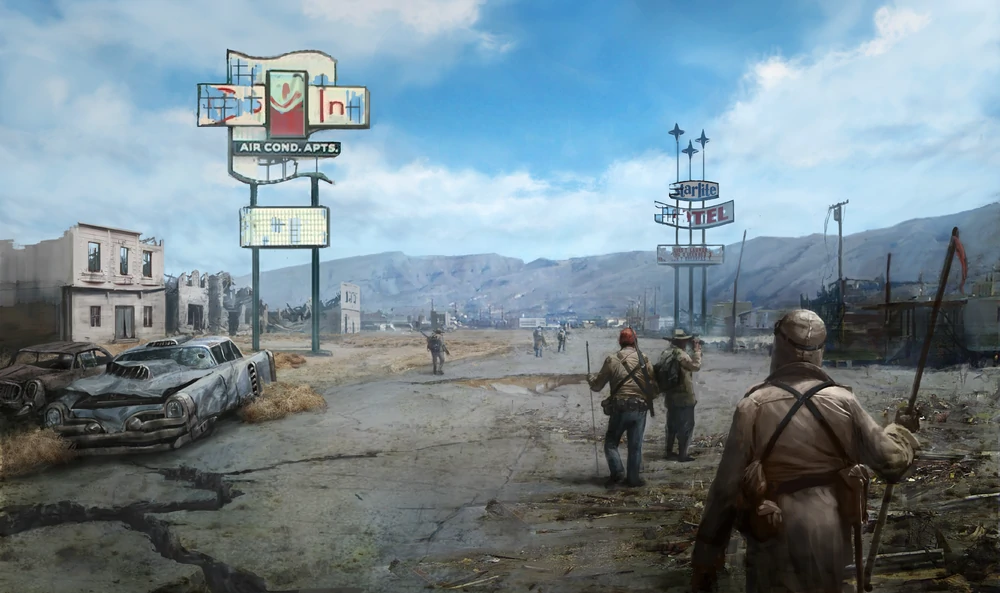
Then, in contrast, we have Fallout New Vegas, a game written by Interplay alums working at Obsidian Entertainment that understand the series, the nuances, the lore, and the RPG-heavy aspects that made the series great, and all of this shines through in FNV’s writing and storytelling. FNV’s writing is much more lighthearted and jovial, making the game feel like a fun romp rather than a dark and broody, desolate world.
Every character, right down to any simple NPC, feels like fully developed and realized people in this world. The main character has a much more intricate and interesting back story than simply growing up in a Vault, and the player gets to slowly uncover this throughout the adventure.
There are several factions within the game, each with rich lore and a defined place within the main story. The writing itself lends itself to decision making and player choice, rewarding those that think outside the box and use their brain rather than bullets to get ahead. There are a wealth of incredible open-ended side quests to get stuck into, and this praise all comes before we even touch on the main story.
The main story is a joy to behold from start to finish, and the player can stop to smell the roses and play as the developer intended, or play like a maverick and skip huge portions and reap the consequences of their actions. Unlike Fallout 3, it’s much more unlikely that an FNV player will have the same main story experience as another.
You may head to New Vegas through Quarry Junction and never see Nipton or Novac. You may kill off all the sub-factions and have a much tougher time during the final battle, or you might kill everyone and have to resort to the Yes Man method.
The brilliance of FNV’s writing comes through its open-ended nature, the attention to detail, the upbeat and often silly nature of the content, and most importantly, the way it puts the player in the driving seat. So in my eyes, FNV is far superior in this department.
Presentation
Fallout 3
As some of you may know, both of these games were made on the same game engine, so the differences are pretty hard to spot. So naturally, the game that does it first will get the plaudits, and when Fallout 3 came out, it wasn’t the best looking game around, but it had enough scope and charm that people didn’t seem to care.
The game has a very somber art style that makes the wasteland seem like a place where doom and gloom were commonplace. There was a green tint on everything, playing into that depressing, somber vibe. The game played up the gore factor, and the marketing for this game really emphasized the ability to pop enemies’ heads like bubblegum.
Overall, it was a game that used gimmicks and the strength of former titles to dictate the art direction. It’s a method that should not have worked as well as it did, but yet, here we are admiring it through rose-tinted glasses, so more fool us.
Fallout New Vegas
I’m not going to dwell on this one too long, as ultimately, the improvements made in FNV in terms of graphical detail are very minute as the games were made in the same engine. However, what is clear in FNV’s presentation is that a lot of new assets were added.
They didn’t just rely on what was leftover from Fallout 3 and this game added tonnes of brand new content unseen within the series, which fit the bill perfectly, all within a very short time. The game also presented itself in a much more fun and accessible way, dropping the gloomy atmosphere for a honky-tonk vibe, complete with an orange tint instead of a green one. As I said, the changes aren’t huge, and for that reason, we can call this section a draw.
World-Building and Design
Fallout 3
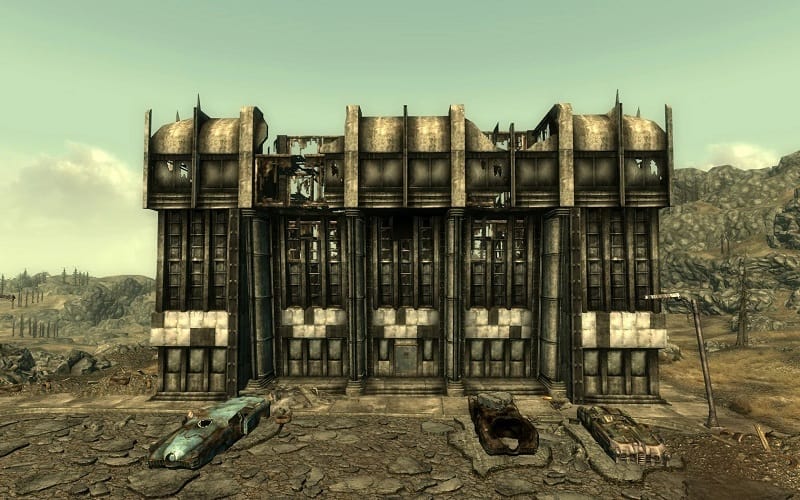
Now I want to look at world design and how each developer created these open worlds, and in truth, both games deserve praise here. While I do have my gripes with Fallout 3’s overall world design as it has, in my opinion, far too many open sections where the player will encounter nothing of interest and an overall design that doesn’t reward exploration.
You have to take into account that this was Bethesda’s first crack of the whip, and they did a pretty decent job. They filled the world with lots of subtle set-pieces, the more built-up areas of this game are some of the most interesting in the entire series, the random events system curbs a lot of the issues caused by the vast, open areas, and the thing that deserves the most praise is how the developers got around potential issues where the game wouldn’t be able to handle loading the entire map at once.
To navigate this, Bethesda would use a subway system and contextual blockages like rubble and the like to fool the player into thinking they were in a completely open environment, when in fact, the more densely packed areas in central DC are segmented through this method.
This was a very clever way to handle the limitations of the hardware, and I will praise any game that goes out of its way to avoid using invisible walls. In summary, it’s not a world packed with content, and it doesn’t reward exploration, but it does a lot of things right.
Fallout New Vegas
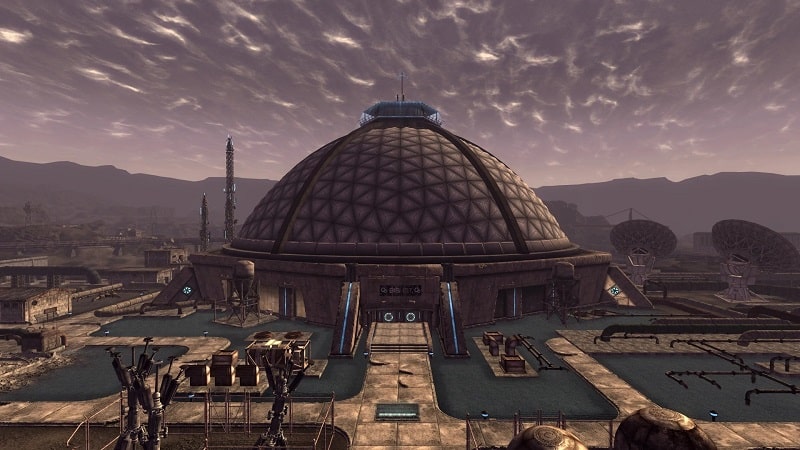
Fallout 3 Did a lot of cool things when it came to world-building, but it walked so that FNV could run. I’ve praised Fallout New Vegas for putting the player at the heart of decision-making already, and this is present even concerning the world design. Right from the word go, the player is given free rein to explore the world as they see fit.
They are given multiple routes for success concerning the main story, they are given tonnes of content to explore, with a new area of interest usually a stone’s throw from the last, and unlike Fallout 3, this game rewards exploration, with almost every area you visit having offering something of note to add to your inventory.
The world feels much more cohesive than Fallout 3; however, what I will say is that Fallout NV had a lot more issues regarding unnatural loading barriers that took the player out of the action. You need only navigate Freeside and the New Vegas Strip to see what I mean. However, even with this immersion-breaking issue at times, FNV is the clear winner in this department.
Audio and Score
Fallout 3
We move on to audio and score, and it’s very hard to separate these two games as, while the soundtracks couldn’t be more different, they both are truly excellent.
First up, Fallout 3 kicked off proceedings with a modern score that offered a blend of ominous, unsettling, and unnerving ambient tracks that players would constantly hear while wandering the wastes.
This made the game feel like a survival horror in a lot of ways, and the claustrophobic subway stations you would have to navigate emphasized this. However, if the player wasn’t in the mood for a spooky time, you could cut the tension with your trusty Pip-Boy radio and play some select tunes via Galaxy News Radio.
These tunes featured pre-1950s classics, including ‘I Don’t Want to Set the World on Fire’ by The Inkspots, ‘Anything Goes’ by Cole Porter, and ‘Mighty, Mighty Man by Ray Brown, to name but a few.
All these tunes would be delivered to your ears by the charismatic disc jockey Three-Dog, and overall, the soundtrack does a killer job of freezing this post-apocalyptic world in time.
Fallout New Vegas
With Fallout 3 having such a strong score, it meant that Obsidian Entertainment would have to at least match the level of quality on offer here and that they did. The FNV score would do away with the ambient overworld noise, and instead, lean into the country and jazz age of the era before the bombs.
Players would get a mix of honky tonk background noise and slow, mellow jazz, depending on how close they were to the neon lights on the New Vegas strip. Plus, when there was a call for tension and dramatic tracks, the game offered those too.
There was more of a range of tunes here to evoke different feelings throughout. Then, once again, the player would have access to a radio station where they could listen to pre-1950s tracks that, again, leaned towards the country and Jazz era.
The game would feature tracks such as ‘Big Iron’ by Marty Robbins, ‘Blue Moon’ by Frank Sinatra, and ‘Aint that a Kick in the Head’ by Dean Martin. Then this game would also give the player the option of tuning into a radio station that just played the hits back to back, rather than one station where a DJ would interject every so often.
However, we have to admit that Mr. New Vegas, FNV’s answer to Three-Dog, was nowhere near as fun to listen to. Overall, I would call this one a tie.
Gameplay and Core Mechanics
Fallout 3
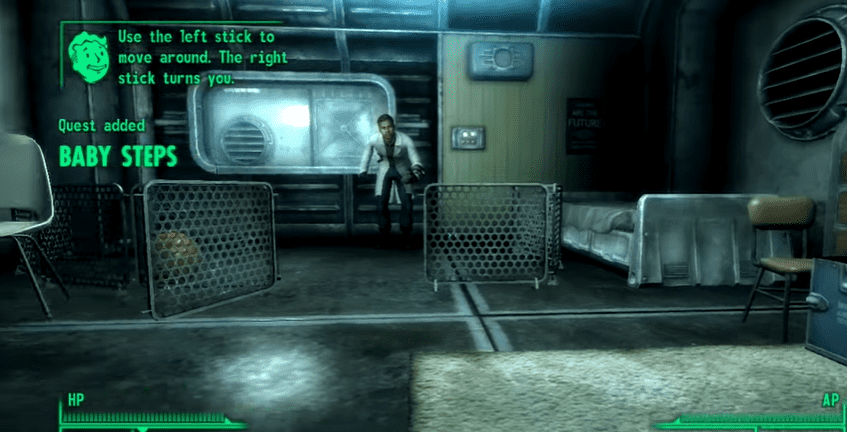
Now we have the core gameplay and mechanics, an area where, in my opinion, one game misses the boat. That game is Fallout 3. Now, don’t get me wrong, Fallout 3 had a lot to do to make this game a commercial success.
It had to take a 1990’s isometric RPG with severely outdated ideals and make a game that appealed not only to new potential fans but the long-term fans of the series.
Well, I believe that Bethesda only tried to do the former. The game stripped back all of the RPG mechanics within the older titles, either dumbing them down or cutting them altogether.
It was clear from the marketing campaign and right from the beginning of the game that this title would flirt with the idea of being an RPG, but in truth, it would mainly be a game that would compromise its ideals to onboard the Call of Duty fanatics of the era.
The game carried over some great ideas like the perks system and the SPECIAL system, to suggest a few, but it all felt like an afterthought as the game was more interested in presenting itself as a pseudo-FPS game.
The pivotal RPG feel was kicked to the curb, and as a result, I believe the game plays like a mediocre FPS game with some very cool assets that have been borrowed and half-heartedly implemented from older titles.
Fallout New Vegas
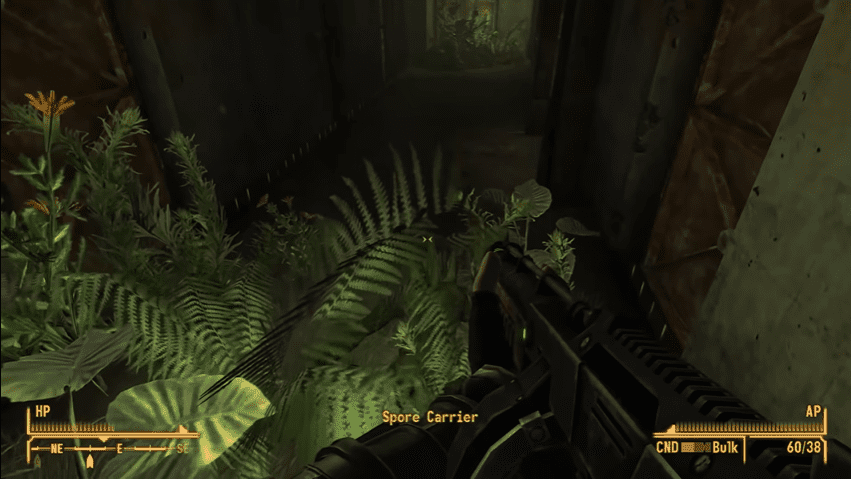
Then we move on to FNV, the far superior game of the two where gameplay is concerned. Now, from the outside looking in, they might not seem all that different, and that is largely down to the limitation of the release schedule that Obsidian Entertainment had to work within and the fact that they had to use the same game engine.
However, when you delve deeper, you begin to realize just how many core details were changed. Some of the most apparent changes are the refinements to the perk system that allowed players to earn a perk with every level instead of every other level, the introduction of the trait system, and the change from Damage Threshold rather than damage resistance to refine the armor and combat systems.
The game also balanced the VATS system to make it a fair system rather than a cheat code where players were invulnerable like in FO3; it added iron sights so that players could play the game like an FPS if they wanted to; they refined the companion system so you could tactically manage their attack patterns and behaviors.
Plus, Fallout New Vegas adjusted the skill checks and a lot of RPG-based mechanics to make the game more of a role-playing game rather than a mindless shooter.
Overall, the game is a much more cohesive and deep gaming experience that encourages emergent gameplay and refines what FO3 offers as much as was possible within the short development window. Again, FNV reigns supreme in this category.
DLC

Fallout 3
Then lastly, we have the DLC campaigns and add-ons for each title, and I have a lot of love for both of the DLC line-ups for these games. FO3 offered quite a varied set of additional campaigns, including Mothership Zeta, The Pitt, Point Lookout, Operation Anchorage, and the nefarious Broken Steel add-on.
Beginning with the latter, Broken Steel let the side down, serving as a rushed addition to the line-up that allowed players to continue the story after the end of the main campaign.
Due to the uproar that this caused and the sheer stupidity of the writing that led up to this event, the fans of this title demanded a fix, and Broken Steel somewhat delivered. It offered a higher level cap for players, allowed them to continue after the last main story mission, and also added some additional end game content.
However, we firmly believe that had the backlash not have been so aggressive, this DLC would have never existed, and it shows in the content produced. So it serves as a black mark on this portfolio of DLC.
That being said, the rest of the content provided is superb for the most part. I have my hang-ups with Mothership Zeta and Operation Anchorage, as these DLC feel a little bit hollow and lack cohesion. However, the concept and the gameplay within these add-ons are sound.
However, the real stars of the show here are The Pitt and Point Lookout, with the latter being the pick of the bunch. These DLCs are some of the best produced in the series, and while Broken Steel is a bit of a letdown amongst the rest of the line-up, I wouldn’t hold that against the rest of the DLC, as a whole, an amazing group of add-ons.
Fallout New Vegas
With the heaps of praise, I threw FO3’s way above, it would be pretty unthinkable that FNV would outdo that game in the DLC department. Well, prepare for the unthinkable. Fallout New Vegas, in my humble opinion, has the most cohesive, detailed, and impressive DLC line-up in gaming history. It’s a bold claim, and even I acknowledge that Honest Hearts wasn’t up to the standard of the rest on show here, but it was still very good, and the rest were sublime.
Dead Money was an incredible concept, a brilliant story told expertly, and had tonnes of deep characters and gameplay gimmicks to keep players engaged. Sure, the collar proximity explosions weren’t to everyone’s taste, but I liked it, and it added tension if nothing else.
Then Old World Blues leaned into the silliness and the sci-fi nature of Fallout, offering a fascinating facility called Big Mountain to explore. Then lastly, there was Lonesome Road, a trip to The Divide where you would finally get some much-needed answers about the life of The Courier before you got shot in the head.
What’s great about this DLC is how they all loosely tie together with some narrative crossover and subtle clues that make nods to what lies in the next DLC you will encounter. We would encourage readers to play the DLC in order of release for this reason. I may be a little biased in this area, but for me, there is only one winner here, and that is once again FNV.
Which is Better?
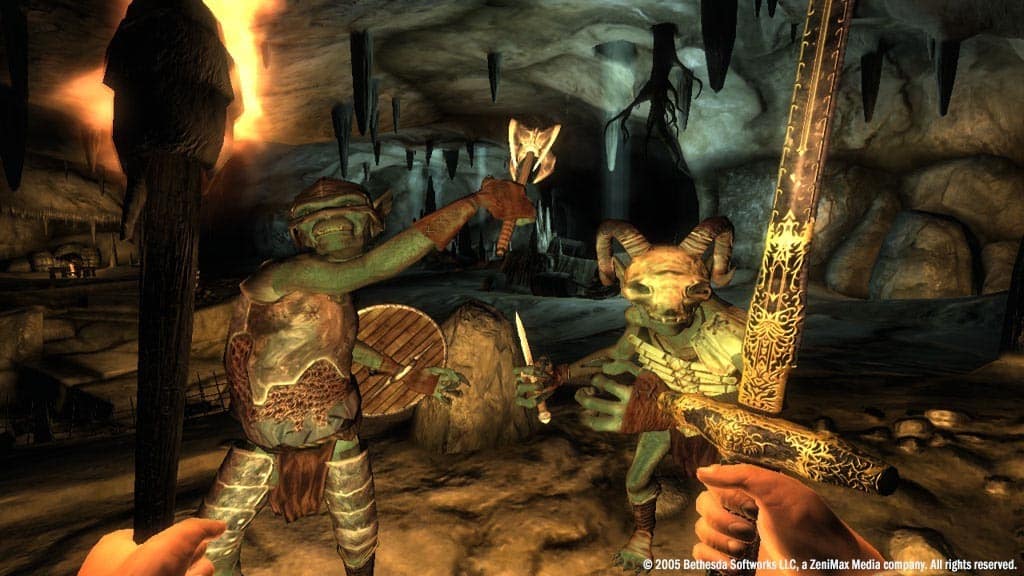
Winner: Fallout New Vegas
Just to immediately clarify, if it wasn’t clear already, I love both games on offer here. However, when you hold the two before you and make a comparison, Fallout New Vegas takes all the best parts of Fallout 3, combines them with the brilliant parts of the original 1990’s Fallout outings, adds some new and interesting things, and combines to offer a game made by Fallout enthusiasts, for Fallout enthusiasts.
The game fixes most of the core gameplay issues, adds a lot more RPG mechanics, and adds some incredible new aspects like the faction and traits systems, for example. It offers a much better narrative experience with better writing, more content, more open-ended quests, and a world that rewards exploration much more than its earlier counterpart.
We could go on, but to sum it up, Fallout 3 is great, but Fallout New Vegas offers all this and so much more, and I often ponder what Obsidian Entertainment could have done if they had more time and resources than they did. Alas, we will never know.
Best Alternatives
You may have played both these games in full already and be on the hunt for the next open-world adventure that can match the look, feel, and quality of these titles.
Well, allow us to give you a nudge in the right direction. Here is a quick list of some incredible alternatives that you need to try:
Fallout 3:
- The Elder Scrolls IV: Oblivion
- The Elder Scrolls V Skyrim
- Far Cry 3
- Fallout 4
- Borderlands
Read also:
Fallout New Vegas:
- The Outer Worlds
- Pillars of Eternity
- Wasteland
- Disco Elysium
- The Elder Scrolls: Morrowind
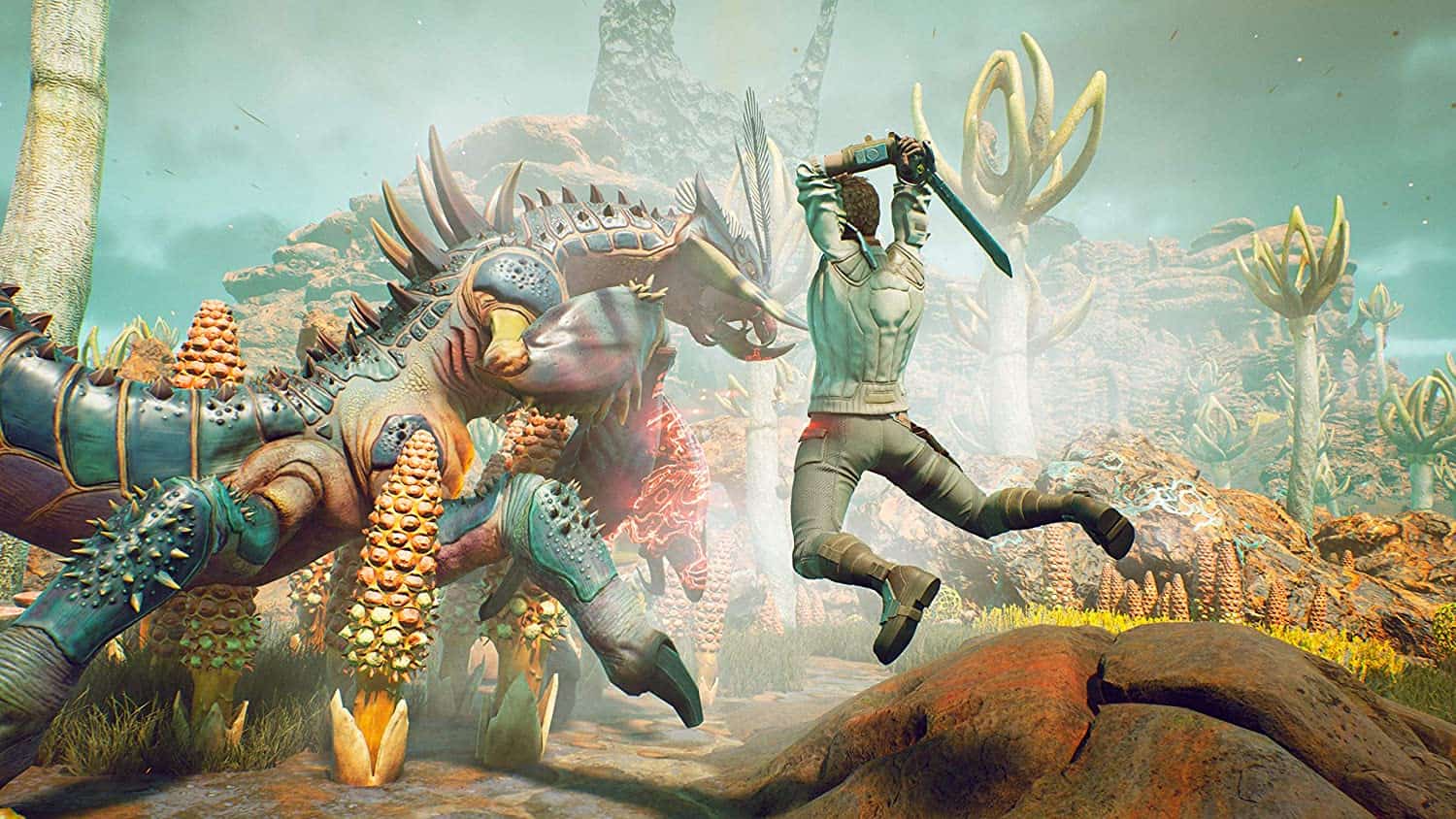
FAQ Section
Question: Will There Be a Fallout New Vegas 2?
Answer: Up until quite recently, we would have said that it was never going to happen. When Obsidian wrapped on FNV, and the game received its review scores, there was an agreement that the team would receive a bonus if it received an aggregate score of 85 on Metacritic. However, the game would only manage an 84 aggregate score.
This was largely due to bugs and limitations of the outdated engine that Obsidian inherited from Bethesda. However, Bethesda failed to recognize this and didn’t pay the bonus, thus leaving a sour taste in their third-party developer’s mouth. However, now that Microsoft owns both Zenimax Media, the parent company of Bethesda, and Obsidian Entertainment, it wouldn’t be unthinkable that this would help rebuild these burned bridges and potentially lead to an FNV sequel. If you want a more in-depth analysis of this, you should check out our FNV2 rumors and speculation article.
Question: Are There Factions in Fallout 3?
Answer: There are in the sense that groups and factions exist within the overworld. There are key settlements and figures within the Capital Wasteland, such as the Brotherhood of Steel, the Enclave, Rivet City, Megaton, and so on. However, unlike Fallout New Vegas, this game does not have a dedicated faction system.
Question: What is Wild Wasteland?
Answer: Wild Wasteland is one of the traits that one can select when creating their character at the beginning of Fallout New Vegas. This is a trait that will enable the silliest encounters within FNV, meaning that strange and unexplainable things could happen throughout your run—like Monty Phyton-themed gags where the player gets ambushed by a gang of old ladies armed with rolling pins. It doesn’t do any harm if you do enable the run, and it can be a lot of fun when you do come across one of these weird encounters, so we would urge you to give it a try.
Same Game Engine, Different Experiences!
As you can see from the comparisons laid out above, while these games were released a very short time apart and used the same game engine, the differences between the two and staggering and clear as day.
While Fallout 3 will forever be remembered as the game that took a dated 1990’s isometric RPG and transformed it into the goliath of the modern gaming industry that it is today, with modern gameplay and an FPS meets RPG format.
It is New Vegas, at least in my humble opinion, that took this formula and perfected it, offering better writing, narrative, loads of quality of life improvements, and a DLC campaign that outshone the admittedly fantastic one presented in Fallout 3.
Fallout 3, when compared to FNV, is great but feels like a less complete package. Like a prototype for what would come later in the Mojave.
Both games are seminal for RPG lovers, and I would urge players to play both, but my heart will always belong to Fallout New Vegas, the best game in the series to date, hands down.
I hope that this comparison serves you well in your next heated argument with other Fallout buffs, and as always, thank you for reading Wasteland Gamers.
Related Reads:

